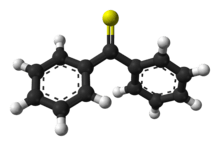Thiobenzophenone
Thiobenzophenone is an organosulfur compound with the formula (C6H5)2CS. It is the prototypical thioketone. Unlike other thioketones that tend to dimerize to form rings and polymers, thiobenzophenone is quite stable, although it photoxidizes in air to form benzophenone and sulfur.[1] Thiobenzophenone is deep blue and dissolves readily in many organic solvents.
 | |
 | |
| Names | |
|---|---|
| IUPAC name
Diphenylmethanethione | |
| Identifiers | |
3D model (JSmol) |
|
| ChemSpider | |
PubChem CID |
|
CompTox Dashboard (EPA) |
|
| |
| |
| Properties | |
| C13H10S | |
| Molar mass | 198.28 g·mol−1 |
| Appearance | Deep blue solid |
| Melting point | 53 to 54 °C (127 to 129 °F; 326 to 327 K) |
| Boiling point | 174 °C (345 °F; 447 K) |
| Hazards | |
| Flash point | no |
Except where otherwise noted, data are given for materials in their standard state (at 25 °C [77 °F], 100 kPa). | |
| Infobox references | |
Structure
The C=S bond length of thiobenzophenone is 1.63 Å, which is comparable to 1.64 Å, the C=S bond length of thioformaldehyde, measured in the gas phase. Due to steric interactions, the phenyl groups are not coplanar and the dihedral angle SC-CC is 36°.[2] A variety of thiones with structures and stability related to thiobenzophenone have also been prepared.[1]
Synthesis
One of the first reported syntheses of thiobenzophenone involves the reaction of sodium hydrosulfide and diphenyldichloromethane":[3]
- Ph2CCl2 + 2 NaSH → Ph2C=S + 2 NaCl + H2S
An updated method involves sulfiding of benzophenone:[4]
- Ph2C=O + H2S → Ph2C=S + H2O
In the above reaction scheme, a mixture of gaseous hydrogen chloride and hydrogen sulfide are passed into a cooled solution of benzophenone in ethanol. Thiobenzophenone can also be produced by a Friedel-Crafts reaction of thiobenzoyl chloride and benzene.[5]
Reactivity
Due to the weakness of the C=S bond, thiobenzophenone is more reactive than its C=O benzophenone counterpart. Thiobenzophenone as well as other thioketones are considered to be superdipolarophiles and dienophiles that rapidly combine with 1,3-dienes in Diels-Alder cycloadditions..[6] The rate of thioketones in cycloadditions is related but not limited to the size of the small HOMO/LUMO energy gap of the π-MOs of the C=S double bond.[2] Reactions between thiobenzophenone and most dienes yield Diels-Alder adducts whereas reactions with monoolefins yield bicyclic compounds.[7]
References
- Metzner, Patrick (1999). "Thiocarbonyl Compounds as Specific Tools for Organic Synthesis". Organosulfur Chemistry I. Topics in Current Chemistry. 204. pp. 127–181. doi:10.1007/3-540-48956-8_2. ISBN 978-3-540-65787-3.
- Sustmann, R.; Sicking, W.; Huisgen, R. "A Computational Study of the Cycloaddition of Thiobenzophenone S-Methylide to Thiobenzophenone". J. Am. Chem. Soc. 2003, 125, 14425-14434. doi:10.1021/ja0377551
- H. Staudinger, H. Freudenberger "Thiobenzophenone" Organic Syntheses, 1931, Vol. 11, p.94. doi:10.15227/orgsyn.011.0094
- B. F. Gofton and E. A. Braude "Thiobenzophenone" Org. Synth. 1955, vol. 35, 97. doi:10.15227/orgsyn.035.0097
- Horst Viola, Steffen Scheithauer and Roland Mayer "Organische Schwefelverbindungen,97. Friedel-Crafts-Reaktionen mit Thiosäurechloriden" Chem. Ber. 1968, volume 101, pages 3517–3529. doi:10.1002/cber.19681011024
- Fisera, L.; Huisgen, R.; Kalwinsch, I.; Langhals,E.; Li, X.; Mloston, G.; Polborn, K.; Rapp, J.; Sicking, W.; Sustmann, R. "New Thione Chemistry". Pure Appl. Chem., 1996, 68, 789-798. doi:10.1351/pac199668040789
- Okuma, K.; Yamamoto, T.; Shirokawa, T.; Kitamura, T.; Fujiwara, Y. "The First Isolation of Benzyne-Thiobenzophenone Adducts". Tetrahedron Letters, 1996, 49, 8883-8886. doi:10.1016/S0040-4039(96)02074-6